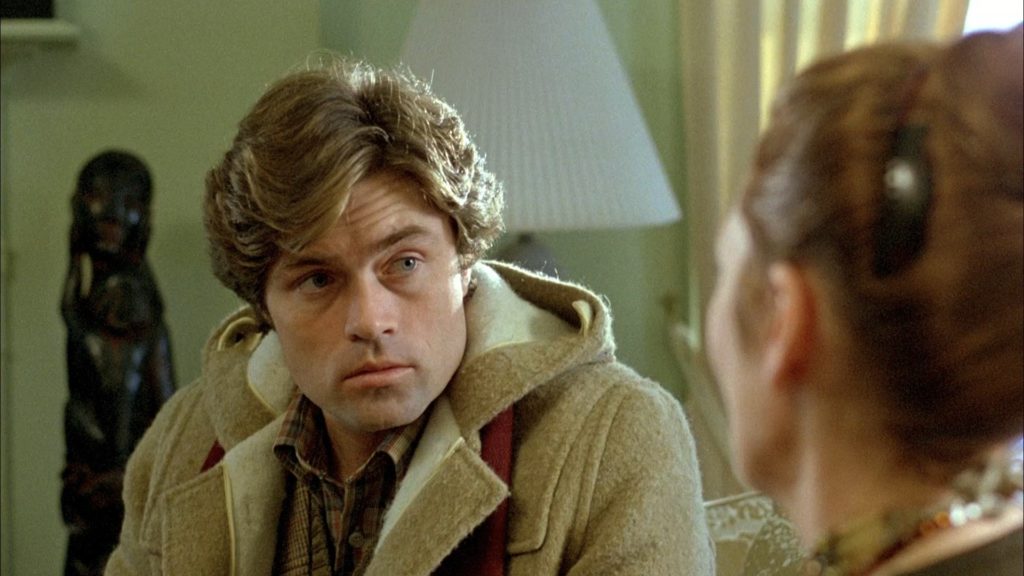Kids today.? When they aren’t gauging their earlobes big enough to smuggle a dinner plate or tattooing every available square inch of cutaneous real estate, they’re transforming into disfigured little hellions and braining you with a meat tenderizer.
Or at least they were in 1979, back when director David Cronenberg was a lot younger but still just as creepy.? His burgeoning obsession with the horrors that surface in our own bodies (a long-standing theme in his work) was on full display in The Brood,? showing us all that we are, in fact, the real monsters.? But this time, he goes a step further, waxing poetic on how our sins manifest in our offspring and how our unresolved issues can be both isolating and deadly.? In typical Cronenberg fashion, everything feels a little off from the start and the entire picture builds with a slow burn of psychological unease that spirals to a flat-out disturbing climax.? And there’s plenty of carnage to keep gorehounds happy along the way, courtesy of a the aforementioned tots–a gang of pastel-hoodied half-pint asexual offspring with an affinity for blunt objects.? And if that wasn’t enough, there’s a touch of theological insight as well.?
Just enough to brood over, you might say.
Construction boss Frank Carveth (Art Hindle) has one of the messiest break-ups on record.? He dropped his mentally disturbed ex-wife, Nola (Samantha Eggar) at the mysterious Somafree Institute a couple of months prior, hoping that the experimental treatment pioneered by psychologist Hal Raglan (Oliver Reed) will help her to deal with the emotional baggage she’s carried for years.? Raglan’s treatment method, called “psychoplasmics,” involves grotesque physiologic changes that he claims help patients free themselves from torturous repressed emotions.? There’s just one problem–when it comes to Nola, it seems as though his methods are backfiring.? Her rage over her violent upbringing (her alcoholic mother physically abused her while her equally alcoholic father refused to get involved) continues to escalate.

Soon Frank begins to worry that Nola is repeating these dangerous learned behaviors because every time he takes their daughter, Candy, to visit Nola, she comes home bruised and scarred.
Frank confronts Raglan, but the good doctor sides with Nola, warning Frank that if he refuses visitation, he’ll face litigation.? Attempting to discredit Raglan, Frank visits a former patient who was horribly disfigured and dying from cancer as a result of Raglan’s treatment.
Afterward, Frank must visit a jobsite, electing to leave Candy with Nola’s mother, Juliana (Nuala Fitzgerald).

When Juliana goes to the kitchen to pour her third drink of the evening, she’s beset upon by two disfigured children who bludgeon her to death.? Candy walks in, sees the carnage, then stoically heads upstairs for a nap (who wouldn’t, right?).
Nola’s estranged father returns to town when he gets word of Juliana’s death, and demands that Raglan release Nola.? He’s also quickly dismissed and implores Frank to help him storm Somafree and break Nola out.? But, wouldn’t you know it? It isn’t long before another of those creepy little kids dispatches him too, using paperweights to put dear old dad out of his drunken misery.? Frank arrives too late to save his father-in-law, but manages to get the better of the demonic rugrat.? When he and the cops take the murderous mite to the coroner, they find out not only does he look like a zombie, but he has navel–and thus, no human mother in the accepted, scientific sense.

When Raglan hears about the murderous children, he finally agrees to close Somafree.? He confesses that their attacks coincide with Nola’s increasingly volatile treatment sessions.? And he he reveals the one card he’s been holding close to his chest: his psychoplasmic experiments on Nola have left her physically manifesting the demon children, forever hampering her chances at Mother of the Year and undergoing a delivery that makes the normal birthing process seem tame.

An intelligent allegory? gestates beneath the squirmy, blood-soaked layers of The Brood.? Cronenberg warns of the dangers of unresolved trauma: a reluctance to deal with past horrors ensures the destruction of the future, and it’s a brutal death of a thousand cuts.? Hurt manifests as harm, but we’re not the only ones who suffer; the collateral damage gets passed on to the ones we love most as the perpetual fallout continues.
If we are ever to end the vicious cycle, we must make the conscious decision to do so.? And whether that confrontation comes after some serious soul searching or qualified, professional therapy (psychoplasmics excluded), as Believers, we need to make sure to consult the Wonderful Counselor.? His grace is sufficient to cover all our sins, is strong enough to overcome the demons of our past and is gentle enough to allow forgiveness of ourselves.? It may not happen overnight, or possibly for years, but with the right help and the blessed assurance of the Holy Spirit, we can put the past behind us.? And like beautiful, new creations, we can be reborn.




